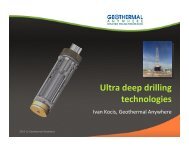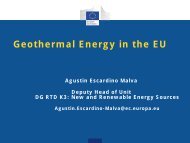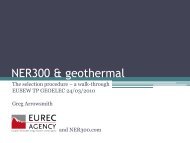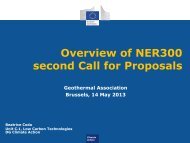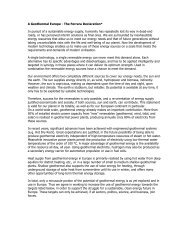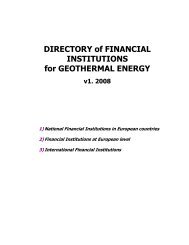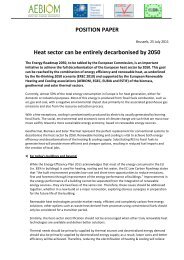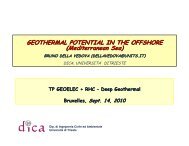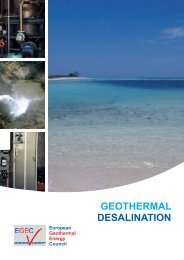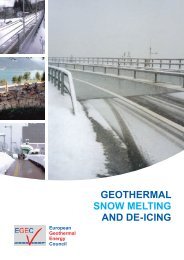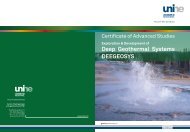Strategic Research and Innovation Agenda for Renewable ... - EGEC
Strategic Research and Innovation Agenda for Renewable ... - EGEC
Strategic Research and Innovation Agenda for Renewable ... - EGEC
Create successful ePaper yourself
Turn your PDF publications into a flip-book with our unique Google optimized e-Paper software.
<strong>Renewable</strong>Heating & CoolingEuropean Technology Plat<strong>for</strong>m2.5 SRA Governing PrinciplesThis <strong>Strategic</strong> <strong>Research</strong> <strong>Agenda</strong> is the first of its kind <strong>for</strong> the renewable heating <strong>and</strong> coolingsector. It provides stakeholders with a structured <strong>and</strong> comprehensive view of the strategicresearch priorities to enable an increasing share of heating <strong>and</strong> cooling to be supplied byRES. The contribution of renewable heating <strong>and</strong> cooling to the EU energy targets by 2020 <strong>and</strong>beyond will be determined by the availability of reliable, efficient <strong>and</strong> af<strong>for</strong>dable technology.Growing the market <strong>for</strong> renewable heating <strong>and</strong> cooling applications, achieving significantbreakthroughs through targeted, collaborative research <strong>and</strong> development activities inRHC technology are all prerequisites <strong>for</strong> the achievement on time of the European Union’sobjectives.This publication provides recommendations to policy makers, funding bodies as wellas to industry <strong>and</strong> research stakeholders on how to prioritise the allocation of resources <strong>for</strong>research, development <strong>and</strong> demonstration (R&D&D) of renewable heating <strong>and</strong> cooling systems.In particular, the SRA can be used as input <strong>for</strong> the identification of the most appropriate areasto fund under Horizon 2020, the successor programme to the Seventh Framework Programme<strong>for</strong> <strong>Research</strong> <strong>and</strong> Development of the European Union.The report is built on five “Governing Principles” which <strong>for</strong>m the basic set of fundamentalassumptions:I. Time scale.It is important to fund R&D work now that will have an impact in different time framesto ensure a continual supply of new ideas to the sector. The report distinguishes betweenthree timelines by when the results from the R&D work covered in the RHC-SRA shouldbe commercially available:• By 2020: Short term 21• By 2030: Medium term• After 2030: Long termThe convention used in this report is to refer strategic <strong>and</strong> research priorities tothe time horizon in which they are first expected to be used in commercial products,not to the year by which widespread use is expected 22 .II. InclusivenessTechnologies <strong>for</strong> renewable heating <strong>and</strong> cooling include a wide range of energycomponents, applications <strong>and</strong> infrastructures. This SRA aims at being ascomprehensive as possible, on the assumption that a single energy technology cannotemerge as the ultimate solution to Europe’s energy challenges. The report expressesoverall research <strong>and</strong> development objectives <strong>and</strong> where possible it sets specific targets,however it is beyond the scope of the SRA to pick winners. Moreover, the targetspresented in this report should not be interpreted as predictions. It is possible that sometechnologies will even exceed them. The efficiency gains <strong>and</strong> cost reductions weredefined on the basis of rational expectations <strong>and</strong> opinions of the SRA’s authors. Furthereditions of the SRA will be produced every five years to reflect the technological progressin the renewable heating <strong>and</strong> cooling sector.21This time period was chosenbecause EU targets <strong>for</strong> renewableenergy, energy efficiency<strong>and</strong> CO 2 reduction alreadyexist <strong>for</strong> 2020.22It should be noted that severalresearch priorities presentedin Chapter 3.3 refer to technologicalachievements whichmay have already been testedat pilot scale. District heating<strong>and</strong> cooling systems arewidely diverse across Europe,<strong>and</strong> it is there<strong>for</strong>e opportuneto refer their priorities to theyear by when most infrastructuresin Europe have attainedthe per<strong>for</strong>mance targets.III. Value chain approach <strong>and</strong> scale of Technology Readiness LevelsPublic <strong>and</strong> private money is required to per<strong>for</strong>m the short, medium <strong>and</strong> long termresearch into all parts of the value chain, as well as non-technological priorities.To realise the potential of the RHC-Plat<strong>for</strong>m’s Common Vision, activities of fundamentalresearch, development <strong>and</strong> demonstration are necessary depending onthe specific technological maturity of the relevant component or system. This reportrecommends that the combined spending of the public <strong>and</strong> private sector shouldbe strategically distributed among topics with commercial relevance in the short,medium <strong>and</strong> long term, covering the scale of Technology Readiness Levels (TRL) frompoint 1 to point 9 (Fig. 8).11



